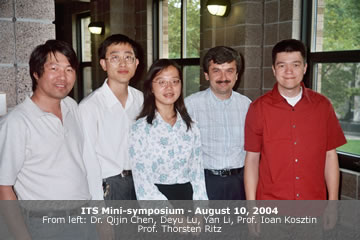|
ITS 2004 Summer Visiting Fellows Program
August
10, 2004 - ITS Mini-symposia at Notre Dame
As part of the 2004 Summer Visiting Fellows Program,
ITS welcomed four seminar speaker's on the University of Notre
Dame campus: Prof. Ioan Kosztin from
the University of Missouri-Columbia, Prof.
Thorsten Ritz from the University of California-Irvine,
Deyu Lu and Yan Li
from the University of Illionois at Urbana-Champaign. They
are members of a research team specially assembled for the
Theoretical Modelling of Transport Properties of Membrane
Channel Proteins and Carbon Nanotubes project which was awarded
the Visiting Fellows grant by the Institute. The mini-symposia
drew a large crowd of Notre Dame faculty and graduate students
interested in the topics.

INSTITUTE FOR THEORETICAL SCIENCES (ITS) SEMINARS:
Molecular and Ionic Transport Through
Channel Proteins and Carbon Nanotubes
Prof. Ioan Kosztin ~ University of Missouri
- Columbia
Abstract: Membrane proteins play a crucial
role in matter, energy and information exchange processes
involving living cells. Recent developments in molecular modeling
methods, in computational hardware and software, combined
with the availability of high resolution crystal structure
of a continuously growing number of membrane proteins, offer
unprecedented opportunities in investigating at atomic resolution
the underlying physical mechanism of molecular transport and
selectivity of channel proteins. At the same time, this effort
can be facilitated by a comparative study of molecular and
ionic transport through, the structurally more simple, carbon
nanotubes. A brief account of recent results and ongoing efforts
in describing the transport of water, small molecules and
ions through aquaporin channel proteins and single-walled
carbon nanotubes will be presented.

Modern Theoretical Approaches to Modeling
Biomolecules and Biomaterials
Prof. Thorsten Ritz ~ University of California
- Irvine
Abstract: The increase in computational power
coupled with recent conceptual advances allows theoretical
and computational biophysics to predict rather than describe
the function of biomolecular or biomimetic systems on the
basis of molecular-level information. We will present several
brief case studies exemplary for this approach, in particular
quantum modeling of energy transfer to elucidate design principles
in photosynthetic systems and the development of a successful
test to identify the biophysical mechanism underlying the
magnetic compass of migratory birds.

Induced
Band Gap of Armchair Carbon Nanotubes by Symmetry Breaking

Yan Li ~ Beckman Institute, University of
Illinois at Urbana-Champaign
Abstract: Armchair carbon nanotubes are metallic
with two sub bands crossing at the Fermi level. By applying
perturbations with angular dependence, it is possible to modify
the electronic band structure and generate a band gap. We
study the effect on the band structure of different angular
modes $V_q\sim \cos q \theta$ within a tight-binding scheme.
Using symmetry arguments, we demonstrate a band gap opening
in these metallic nanotubes when certain selection rules are
satisfied for both potential and nanotube structure. We estimate
band gap opening as a function of both the external potential
and the tube radius and suggest an effective mechanism of
metal-semiconductor transition by combination of different
forms of perturbations.

Electronic
Structure and Dielectric Behavior of Finite-length Single-walled
Armchair Carbon Nanotubes 
Deyu Lu ~ Beckman Institute, University of
Illinois at Urbana-Champaign
Abstract: The electronic structure and dielectric
screening of finite-length armchair carbon nanotubes are studied
within a tight-binding model, which well captures the oscillation
pattern of the band gap as the tube length increases. We find
that: (1) the parallel screening constant grows almost linearly
with the length and shows little dependence on the band gap;
(2) the perpendicular screening is strongly related to the
band gap and converges to its bulk value when the length exceeds
tens of radius. Our approach is employed to study the polarization
effect of a short (6,6) nanotube in a wet environment, when
water is inside the tube. This situation is of interest for
biomimetic uses of carbon nanotubes. Incorporating this method
into classic molecular dynamics simulations will help us to
understand the molecular transport dynamics through carbon
nanotubes.

|